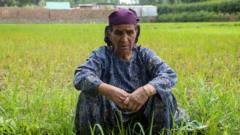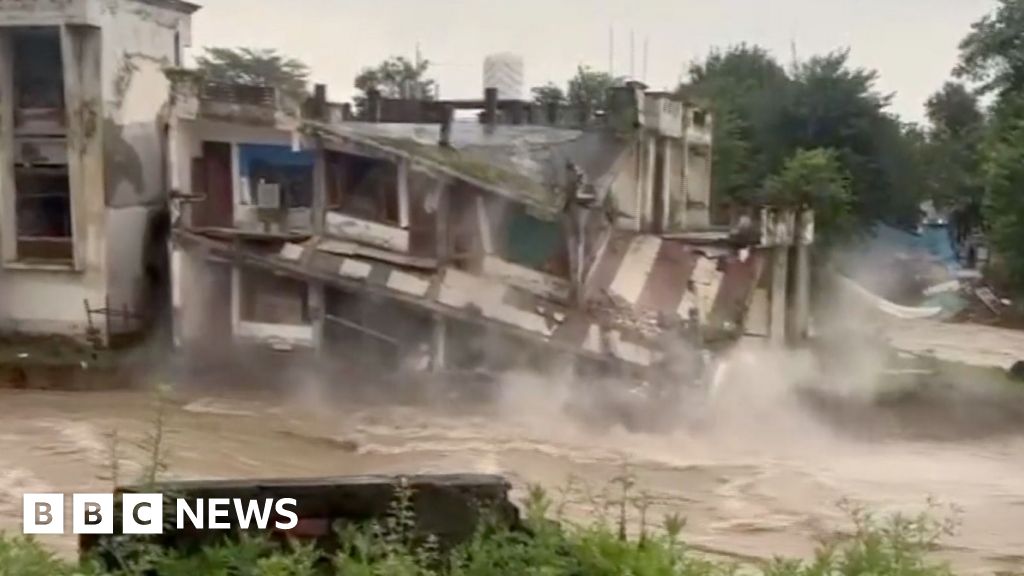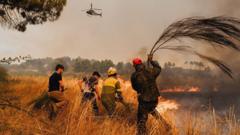An unyielding heatwave has ensnared Kashmir in recent months, leaving farmers and residents scrambling to cope with unprecedented conditions. Zaina Begum, a farmer in Pulwama district, stood next to her parched paddy field, desperately waiting for rainfall to revive her dying crops. "When it did finally rain this week, it was already too late," she lamented, reflecting the grim reality many face.
Temperatures have reached alarming levels, soaring to a staggering 37.4°C (99.32°F), the highest recorded in the region in seven decades, surpassing the seasonal average by at least 7°C. June saw the hottest days experienced in 50 years, prompting the authorities to close down educational institutions for two weeks. While heavy rains provided temporary respite, experts warn of even more extreme weather looming on the horizon.
Kashmir, a picturesque Himalayan region known for its cooler climate, is now grappling with changing weather patterns detrimental to local livelihoods. Many farming families find themselves caught in a downward spiral, suffering from diminished produce quality and increased financial losses. Zaina's family has cultivated paddy for generations but reported not harvesting a single healthy batch in the past five years, as rainfall increasingly becomes unpredictable. "This summer feels like our worst fears have come true," she added, heartbroken over their dwindling prospects.
A 2021 study indicates that maximum temperatures in Kashmir have risen by 2°C over the past four decades, equivalent to a 0.5°C increase per decade. Mukhtar Ahmad, head of the Indian weather department’s centre in Srinagar, noted that the region has already endured three heatwaves this season, with major water sources drying up.
The impact is evident across Kashmir; in Bandipore district, rows of wilting apple trees are the unfortunate legacy of climate change. Ali Mohammad, who transitioned from rice farming to apple orcharding two decades ago due to uncertain weather, now faces similar struggles as even his apple crops suffer from a lack of water. "For the last two months, there was no rain and the irrigation canals dried up," he explained.
Local residents, unaccustomed to severe heat, are also feeling the brunt of this weather shift. Parveez Ahmad, a 63-year-old from northern Kashmir, experienced a health scare as he was rushed to the hospital due to severe breathlessness attributed to the heat.
Environmentalists attribute this extreme weather pattern to climate change, stating that it has provoked erratic weather events and extended dry periods during both summer and winter. Hotter summers accelerate the melting of glaciers, jeopardizing water availability, health, and agricultural productivity.
Additionally, the region has witnessed an alarming decline in its tree cover, with Global Forest Watch reporting a loss of nearly 0.39% of total tree cover between 2001 and 2023, primarily driven by deforestation and urbanization. As agriculture gives way to concrete development, the natural regulation of local climate falters, exacerbating heat issues.
Despite this critical situation, critics argue that environmental concerns rarely garner adequate attention from regional politicians. While the spokesperson for Kashmir’s elected government, Tanvir Sadiq, claims the administration is taking climate change seriously, farmers like Zaina urge immediate action. "If it doesn’t happen soon, we will be doomed," she warned, emphasizing the urgency of their plight as the country navigates this growing crisis.
With local agriculture under siege and public health at risk, Kashmir's residents offer a poignant reminder of the global implications of climate change, emphasizing that solutions need to rise in tandem with the temperatures.





















